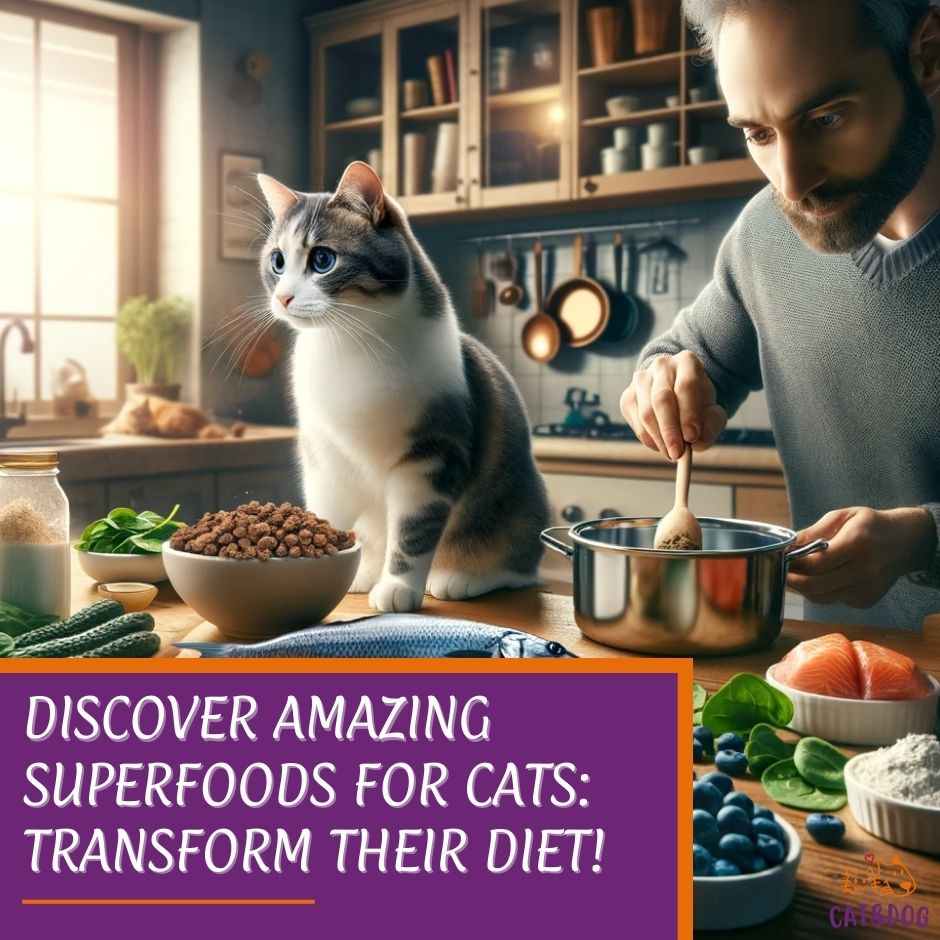Ever wonder if your feline friend can join in on the superfood for cat trend that could enhance your cat’s health?
You’re not alone. Health-conscious cat owners like you are always on the lookout for ways to boost their pets’ nutrition and overall well-being.
Superfoods for cats are nutrient-rich food options that provide abundant vitamins, minerals, and antioxidants, including lean meat, which is a source of protein, iron, B vitamins, and natural fats.
But if you feel that making a superfood sounds difficult to do, you can consider giving vitamins in tablet form to your cat.
Well, it’s also quite tricky for pet owners who want to give vitamins in tablet form to their cats. Maybe one of the easiest ways you can try is to slip vitamin tablets into your cat’s food.
Eggs, in particular, are a great source of natural fats and other essential nutrients for cats. Cooked eggs — whether baked, boiled, or poached— are super healthy treats for your cat. (1)
They contain protein, natural fats, thiamine, lysine, and choline. Eggs also contain vitamins A, B12, and D. (2)
If you prefer to feed your cat raw eggs, please ensure they are pasteurized in-shell to avoid contamination with potentially pathogenic bacteria such as Salmonella, complementing your kitty’s diet beautifully.
It goes the same when you want to feed your cat any raw diet, make sure the food is safe from bacteria or this will be a nightmare for your cat.
Another superfood for cats is oily fish like salmon, anchovies, and sardines. These fish are high in Omega-3 fatty acids, which benefit cats. (3)
Incorporating avocado oil into your cat’s diet, as part of their nutritional plan, can enhance their intake of essential fatty acids, supporting skin and coat health.
However, it is important to avoid feeding your cat tuna, as it contains mercury, which can be harmful when consumed frequently.
Lean pork, beef, or chicken are also excellent protein sources for cats, but be sure to avoid using sauces or seasonings when preparing these meats for your furry friend.
Instead, use simple cooking methods such as boiling, baking, or grilling. Don’t forget to save the leftovers for a tasty treat later on!
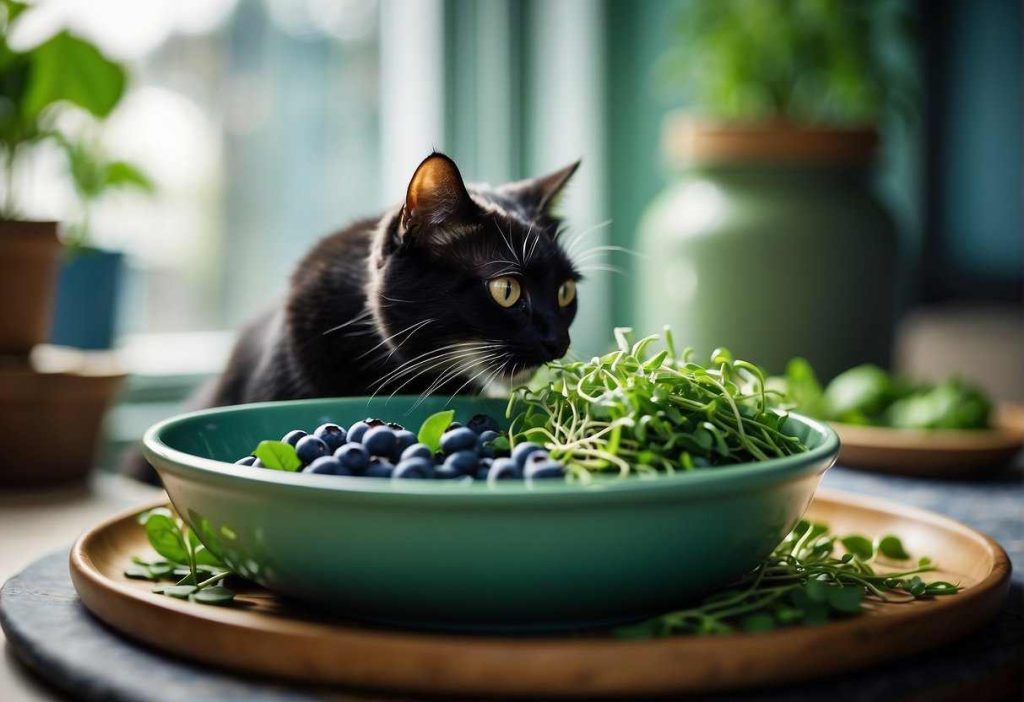
Many of the nutritious items you’re adding to your smoothie or salad might just be the perfect addition to your cat’s feeding routine, backed by veterinarians and full of health-boosting properties.
When adding superfoods to your cat’s meals, it’s crucial to ensure they are safe dietary choices for cats, keeping in mind their unique nutritional requirements
One such food is pumpkin, which is not only a source of potassium and antioxidants, but also an amazing source of prebiotic fiber and folate, making it a great option for cats with sensitive stomachs suffering from constipation or diarrhea.
Another superfood for cats is pomegranate, which is nutrient-dense and rich in antioxidants.
However, it is important to note that pomegranate seeds may pose a choking hazard, so it should only be fed to cats in moderation and under supervision.
It is important to ensure that the pomegranate is free of additives, spices, or flavorings before feeding it to your cat.
Key Takeaways
- Superfoods add essential nutrients and antioxidants to a cat’s diet.
- Cat owners are looking for reliable, practical ways to enhance their pet’s meals.
- Incorporating the right superfoods can lead to improved feline health and vitality.
Superfoods for Cats: A Comprehensive Guide
Have you ever wondered what superfoods can do for your cat’s health? Let’s dive into the world of feline-friendly superfoods to keep your little hunter in tip-top condition!
Cranberries: These tiny fruits are like little red health bombs for your cat. Loaded with antioxidants, they help support urinary tract health, reducing the risk of infections. (4)
Blueberries: Just like their cranberry cousins, blueberries are antioxidant powerhouses. As a bonus, they also help reinforce your cat’s immune system. (5)
Dandelion leaves and roots: Surprised? These backyard plants aid in digestion and can support liver detoxification. Just ensure they’re free from pesticides before sharing them with your cat.
Chicken, turkey, and fish: These protein-rich staples aren’t just tasty; they’re full of essential amino acids and taurine, critical for heart and eye health.
Omega-3 fatty acids: Found in fish oil or salmon, these help your cat’s coat shine and reduce inflammation.
Pumpkin or psyllium husk: These fiber-rich foods can keep your cat’s digestive system running smoothly.
Here’s a quick nutrient breakdown:
| Superfood | Key Nutrients | Benefits for Cats |
| Cranberries | Antioxidants | Urinary tract health, infection prevention |
| Blueberries | Antioxidants, Vitamins C and K | Immune system support |
| Dandelion | Vitamins A, C, and K, Iron and Potassium | Digestion aid, liver detoxification |
| Poultry & Fish | Protein, Taurine | Muscle health, heart and eye function |
| Omega-3 Fatty Acids | EPA & DHA | Skin and coat health, anti-inflammatory |
| Fiber Sources | Dietary Fiber | Digestive regularity |
Remember, while superfoods are beneficial, they should complement a balanced diet tailored to your cat’s specific needs. If you’re unsure about portions or new foods, consulting with your vet is always wise.
Feeding your furry friend right doesn’t have to be a purr-fect mystery. With these superfoods, you’re on your way to ensuring your cat lives a long, healthy, and happy life.
Keep these snacks as treats, and watch your cat thrive!
Incorporating Superfoods into Your Cat’s Diet
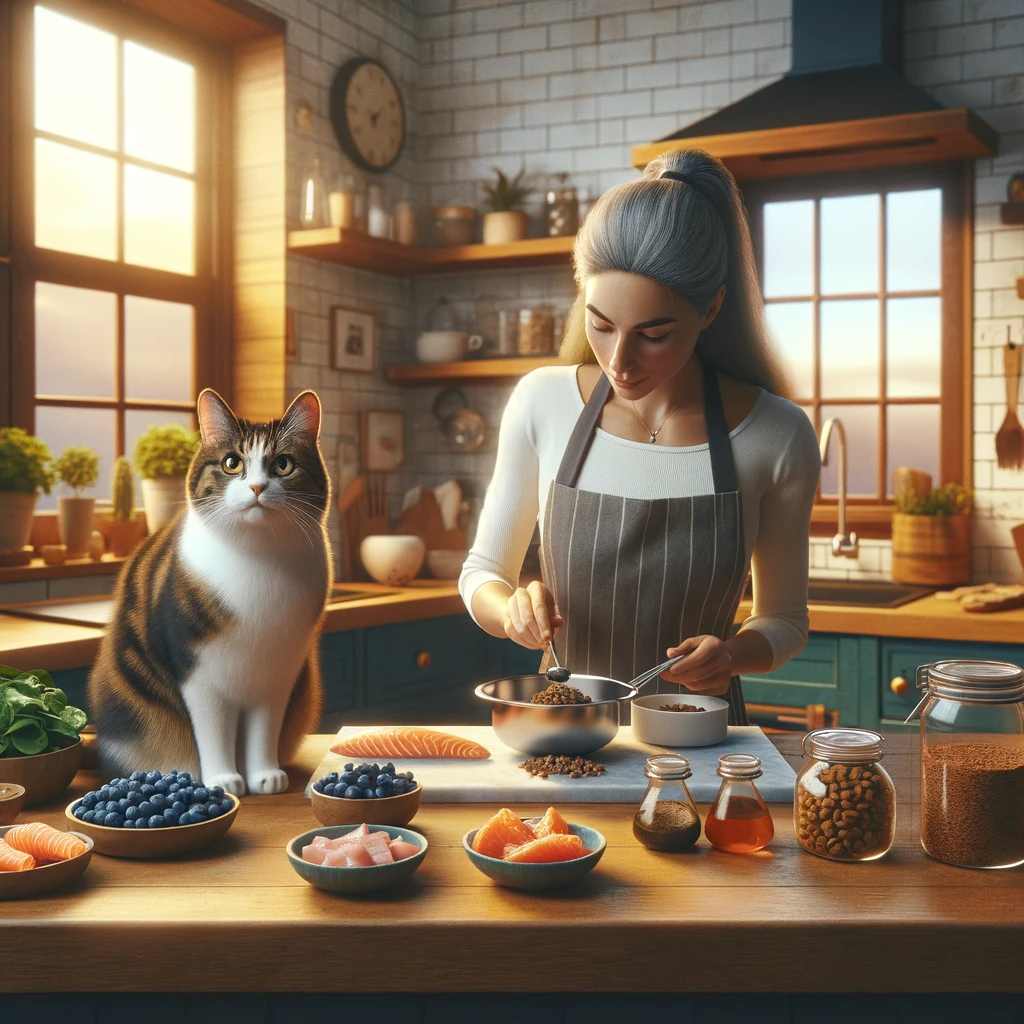
Have you ever wondered how to spice up your furry friend’s meals? Well, superfoods might be the unique zing your cat’s diet needs. But remember, balance is key, and a little goes a long way!
Safe Preparation and Serving Tips
- Cooking Methods: Steaming veggies like broccoli ensures softness for easy digestion. Remember, no added spices or salt!
- Portion Size: A tiny bit of these nutrient-packed foods is enough for your cat. Use a pinch or a small spoonful to avoid overwhelming their system.
After ensuring that steamed vegetables and the correct portion sizes are safely prepared for your cat, it’s also vital to consider the use of safe cat cake ingredients when celebrating your feline’s special occasions.
Just like these nutrient-packed superfoods, the ingredients you choose for a celebratory cake should support your cat’s health and dietary needs.
Tailoring Superfoods to Individual Cat Needs
- Digestive Health: Is your cat prone to tummy woes? Easy-to-digest pumpkin could be your go-to, being rich in fiber.
- Allergies or Sensitivities: Foods like dandelion leaves may help. Always check in with your vet for a personalized plan.
Tips for Transitioning
- Gradual Introduction: Start with a smidge mixed into their current food.
- Observe and Adjust: Keep an eye out for any signs of upset. If all’s well, you’re on the right track!
When considering superfoods for health conditions, it’s not one-size-fits-all. Got a cat with arthritis? Omega-3s found in salmon can support joint health.
Examples & Suggestions
- For Energy: Lean meats provide protein for active cats.
- For Coat Health: Omega-3 in salmon gives a shine to their fur.
Want to make mealtime exciting?
Here’s a little trick: rotate superfoods to keep your cat curious about what’s next. And hey, you might just become their favorite chef! Remember, moderation is the secret ingredient.
You can also explore value-for-money cat food options that include these superfoods can provide your cat with a nutritious diet without breaking the bank
Scientific Backing and Vet-Approved Recommendations
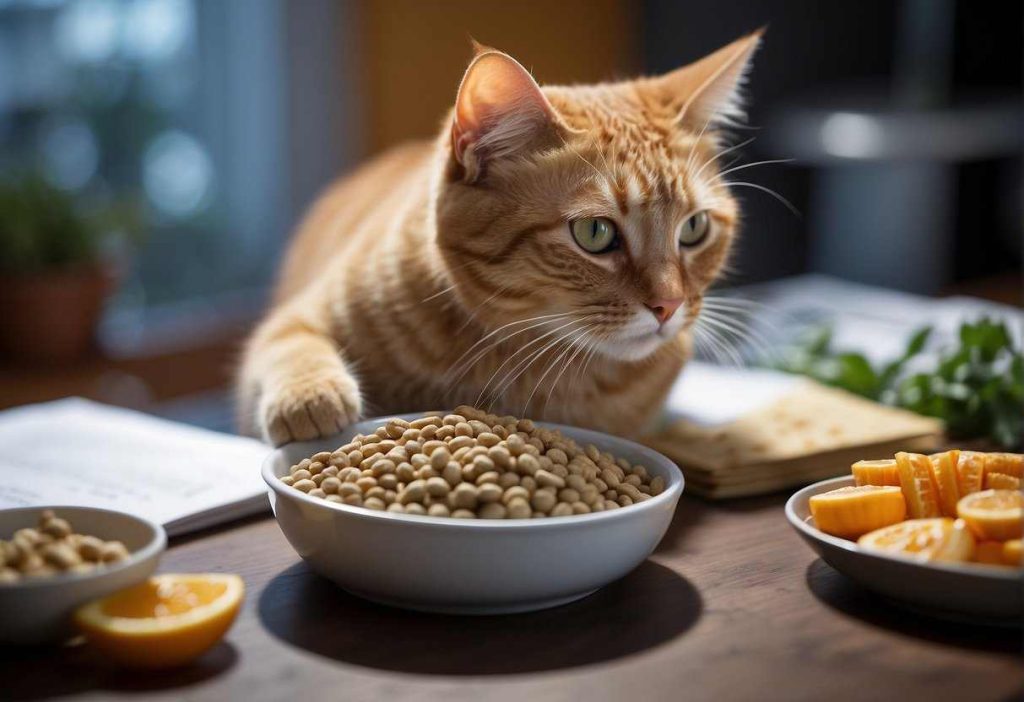
Ever wondered if those touted superfoods work for your furry friend? Well, vets are giving a thumbs up to several nutrient-packed foods that can boost your cat’s health.
Guess what? Research is on their side too!
Feeding Your Cat for Urinary Health Cranberries, for example, aren’t just a festive treat. They’re packed with antioxidants and have properties that may help maintain your cat’s urinary tract health. How so?
By putting up a fight against certain bacteria that could cause trouble.
Nutritionally Dense Superfoods
- What’s the deal with these superfoods, anyway? Here’s the scoop:
- Antioxidant-rich: Tackles free radicals and may boost immunity.
- High in fiber: This can aid digestion and keep those hairballs in check. (6)
- Omega fatty acids: Think shiny coat and healthy skin.
- Vitamins and minerals: For overall well-being, because your cat deserves to feel perfect.
Including chia seeds in your cat’s diet can be particularly beneficial for their coat, as chia for cat coats offers a natural, rich source of omega-3 fatty acids, promoting a shiny and healthy fur.
But hey, remember that moderation is key before you go wild in the pet food aisle. Too much of a good thing can become a bad thing real quick!
Vet-Approved Picks The research into the latest veterinarian guidelines is fresh and continually updated to ensure your kitty is getting top-notch nutrition.
Brands often mentioned by vets include Wellness, Purina Pro Plan, and Hill’s Science Diet, especially for those with special dietary needs.
So, are you ready to give your cat the superfood advantage?
Practical Application of Superfoods in Everyday Diets
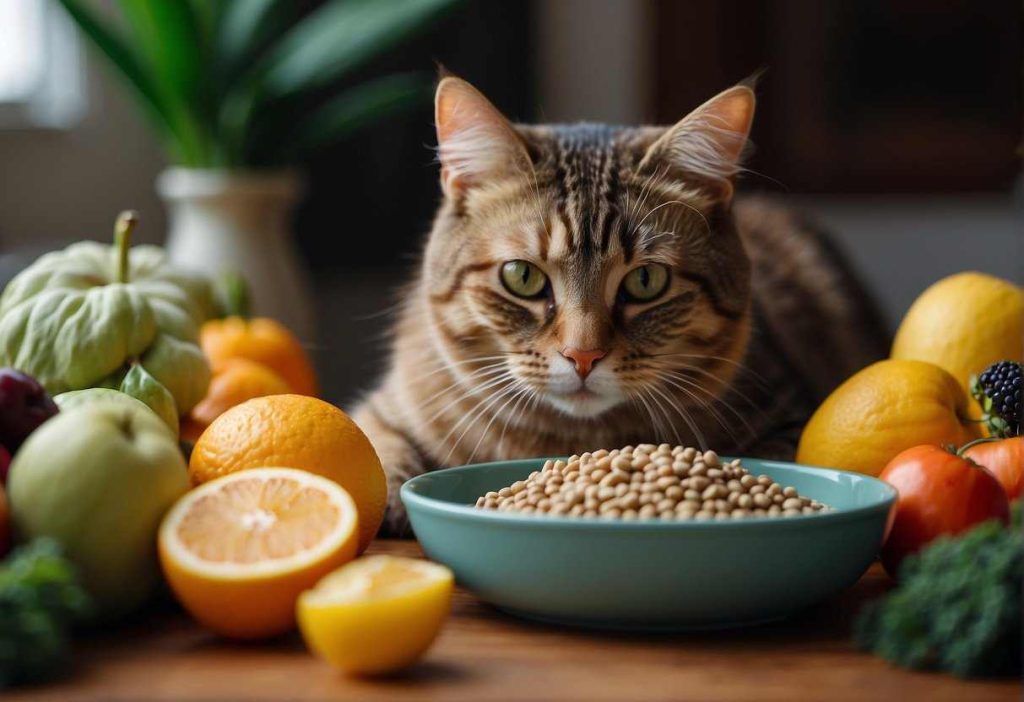
Here’s a straightforward guide on bringing these health-boosting foods into your cat’s diet without any fuss.
While considering the inclusion of superfoods in your cat’s diet, also explore healthy low-carb wet food options for felines to provide a balanced and nutritious meal plan.
Easy-to-Implement Superfood Strategies
Trying to mix superfoods into your cat’s daily nosh? Start small:
- Berries – Trick them with a treat! Toss a few blueberries into their meal for a burst of antioxidants.
- Tip: Freeze them for a crunchy snack!
- Leafy Greens – Trying something like spinach? Chop it fine and mix it with their regular food.
- Omega-3s – A spoonful of fish oil or a few flakes of cooked salmon will do wonders for their coat.
Remember, balance is key; don’t overdo it.
Monitoring and Adjusting Superfood Intake
Your cat’s reaction is the best feedback! Here’s what to look for:
- Glossier coat or increased energy? You’re on the right track.
- Upset stomach or disinterest? Time to readjust.
Keep an eye out for these, and tweak their meals as you go. No drama; just observe and adapt.
A bite-sized recap:
- Start with small portions of superfoods.
- Observe your cat’s reactions.
- Adjust the variety and quantity based on their response.
Easy-peasy feline nutrition! Your kitty gets a taste of the good stuff, and you get to feel like a super pet parent. It’s a win-win!
Creative Ways to Introduce Feline’s Superfoods
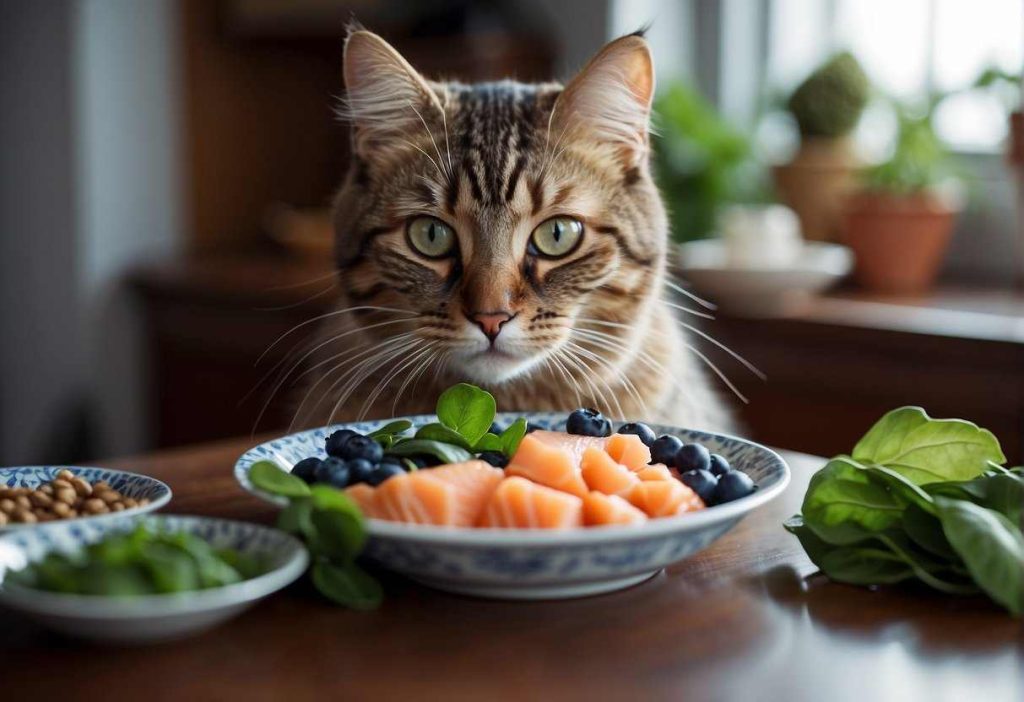
Let’s get creative with superfoods that are not only vet-approved but will have your cat meowing for more!
Berry Good Treats: Cats can be picky, but who can resist berries? Blueberries, for example, are bursting with antioxidants. Try freezing them for a crunchy snack or mashing them into your cat’s wet food.
It’s like a berry blast of health!
- Cranberry Sprinkle: This little red fruit is a powerhouse for urinary tract health. A light sprinkle of dried cranberries over your cat’s dinner plate can make a huge difference. Just ensure they’re unsweetened and given in moderation.
Goji Berry Gourmet: Start with a tiny amount of goji berries. They’re nutrient-rich and may help ward off pesky health issues as your cat ages. Just remember, a little goes a long way!
Here’s a tip: Always introduce new foods slowly and in small amounts. Keep an eye out for any unusual reactions or dislikes. Check out a simple starting point:
| Superfood | Serving Suggestion |
| Blueberries | 3–4 berries, mashed or whole |
| Cranberries | 1 teaspoon, dried and unsweetened |
| Goji Berries | Mix a few into their regular food |
Remember, hydration is key for your kitty’s health. Foods high in moisture content, like melon or cucumber, can be great additions to their superfood list.
Why not make mealtime interactive? Try hiding these superfoods in puzzle feeders to stimulate your cat’s body and mind. Imagine the fun as they hunt for their healthy treasures!
Keep it simple, and tailor the superfood experience to your cat’s liking. With these tips, you’re well on your way to boosting your feline’s diet with excitement and nutrition.
A Broad Focus on Pet Superfoods Nutrition
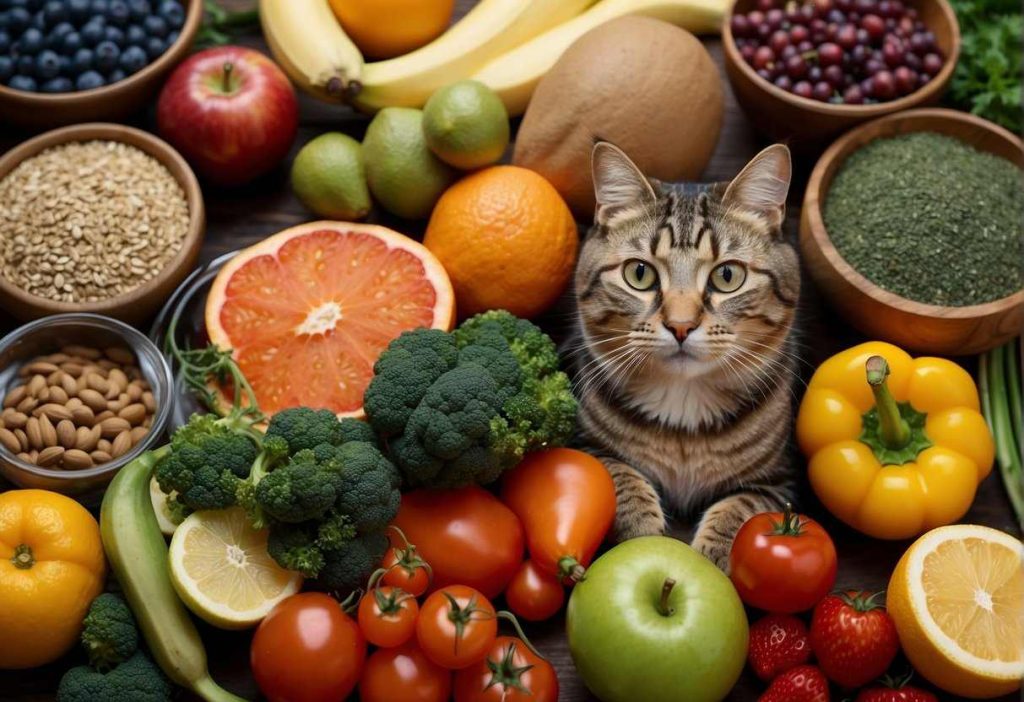
Some superfoods, full of vitamins and antioxidants, can provide remarkable health benefits tailored just for them, including human food.
Added to a balanced diet, the right superfood will give your feline a variety of health boosts, from digestive support to heart health and fur conditions.
However, it’s important to note that while individual superfoods can be beneficial, it’s best to ensure that your cat’s everyday diet includes superfood ingredients, such as peas and lentils, in their dog food.
This will ensure that their diet is balanced and provides a wide range of nutrients for optimal feline health.
Here are some of the best superfoods for cats to look for in their dog food: great superfood carrots, peas, and blueberries, which can help prevent disease processes and promote overall health.
Why Are Certain Foods ‘Super’ for Cats? Cats require a fine balance of certain nutrients, like taurine and arginine, that are essential for their well-being.
Superfoods, including those tiny cranberries, aren’t just a burst of color; they offer antioxidants that support urinary tract health—a common concern for many cats.
Need a quick, delicious health boost? Think of blueberries. It’s not just about the juicy taste; these small berries are antioxidant powerhouses. Here’s an idea: pop a few in with their regular food for a special treat!
Let’s Talk Specifics:
- Cranberries: Packs antioxidants, supports urinary tract
- Blueberries: Loaded with antioxidants and fiber
- Dandelion Leaves and Roots: Who knew that this common garden invader could aid in your cat’s digestion and support their liver? (7)
Remember, the goal is to support your cat’s health without tipping the scales of their delicate diet.
Balance and moderation are key—after all, you wouldn’t want your four-legged pal turning their nose up at dinner time, would you?
Here’s a little table to summarize the superfoods mentioned:
| Superfood | Benefit |
| Cranberries | Antioxidants, urinary tract support |
| Blueberries | Antioxidants, fiber |
| Dandelion | Digestive aid, liver support |
Incorporating these foods can make a tangible difference in your cat’s vitality and health.
Just a few small tweaks to their diet, and you’ll have a purring, content furball, boasting the sleek coat and bright eyes that every cat lover adores! What’s not to love about that?
Quick Recap
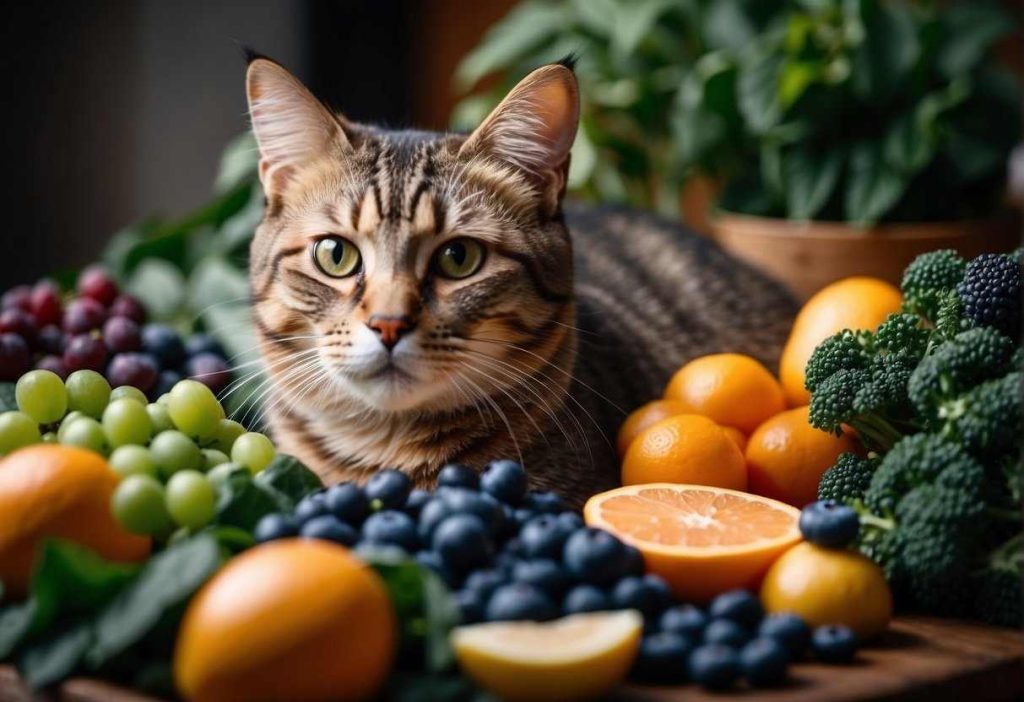
Let’s pounce into a crisp summary of why superfoods are the cat’s meow when it comes to feline health.
- Antioxidants Galore: Remember the mention of cranberries and blueberries? These berries are tiny warriors battling against free radicals, promoting cellular health and longevity.
- Urinary Tract Support: Those same cranberries are renowned for their ability to help maintain a healthy urinary tract, keeping pesky bacteria at bay.
- Digestive Aides: Dandelion leaves are not just garden invaders; they actually can improve your cat’s digestion and support liver detoxification. Always ensure they’re free from pesticides before offering them to your kitty.
- Rich in Fiber: Superfoods such as blueberries contribute to a high-fiber diet, which can aid in preventing hairball issues and maintaining a healthy weight.
Here’s what you’ve unwrapped today:
| Superfood | Benefit |
| Cranberries | Supports urinary tract health |
| Blueberries | Antioxidant-rich, aids overall wellness |
| Dandelions | Promotes healthy digestion |
Curiosity didn’t kill the cat; it made them healthier! Keep digging into the world of feline nutrition to find more tantalizing tidbits that can bring purrs and playfulness to your furry companion’s daily routine.
Want to dive deeper? There’s a treasure trove of resources and studies awaiting your keen eyes. Happy exploring!
And happy feeding!
Frequently Asked Questions
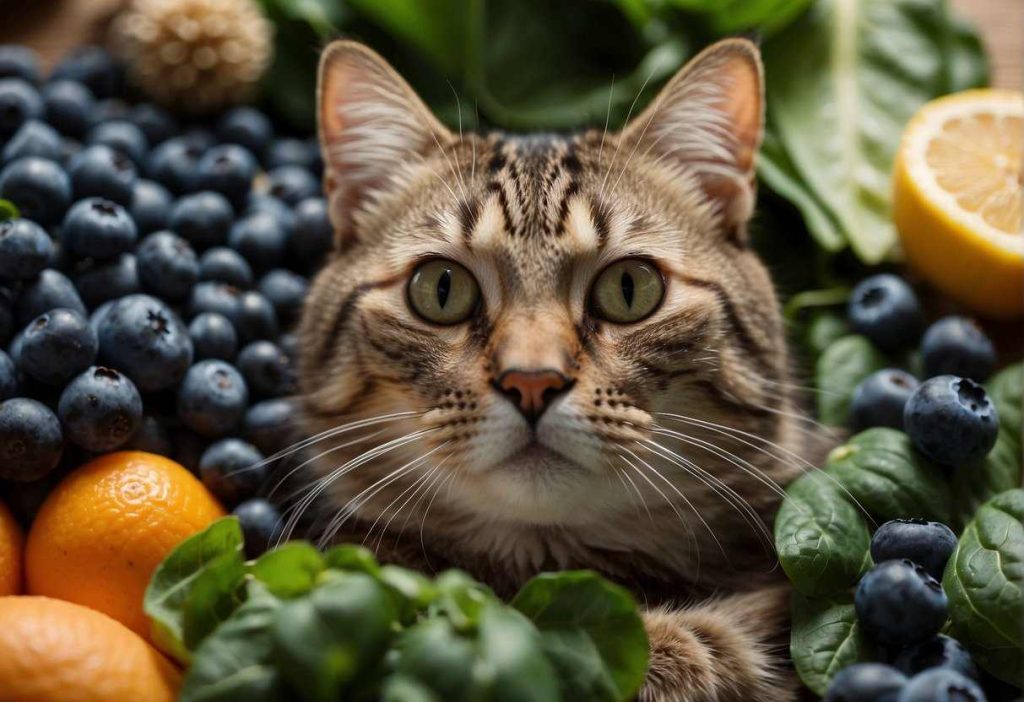
When it comes to boosting your fluffy friend’s diet with superfoods, you might have a few questions.
Let’s go straight to what you’re wondering about how to give your cat the royalty treatment they deserve with these nutritious additions.
What are the top superfoods recommended for cats?
Cranberries and blueberries are among the top superfoods for cats because of their high antioxidant content.
Lean meats are also essential, as cats are natural carnivores and thrive on proteins.
How can I introduce superfoods into my cat’s diet without causing digestive issues?
Start by mixing small amounts of superfoods with your cat’s regular food. This gradual introduction helps prevent any digestive upset.
Keep an eye on your cat’s reaction to new foods and consult with your vet if you notice any issues.
Are there any superfoods that are particularly good for older cats?
Antioxidant-rich foods like blueberries can support the health of older cats by combating oxidative stress.
Omega-3 fatty acids, found in fish like salmon, are also great for maintaining joint and cognitive health in senior cats.
Can superfoods help with my cat’s specific health condition (e.g., kidney disease, diabetes)?
While superfoods can contribute to overall health, they should not replace any prescribed treatment.
Some superfoods may have beneficial properties for certain health conditions. For example, cranberries may support urinary tract health.
Always consult your vet for advice specific to your cat’s needs.
Are there any risks associated with feeding my cat certain superfoods?
Yes, not all superfoods considered healthy for humans are safe for cats.
For instance, some superfoods can cause an imbalance if fed in large amounts or may be toxic (like onions and garlic). It’s crucial to do your homework and talk to your vet.
How often should I feed my cat superfoods?
It’s best to view superfoods as supplements to your cat’s diet rather than main meal components.
A couple of times a week can be a good starting point, depending on the superfood and your cat’s health status.
Can I replace my cat’s regular food with superfoods?
Not at all. Superfoods should complement your cat’s balanced diet, not replace it.
Your cat requires a specific nutrient profile that commercial cat foods are formulated to provide.
Superfoods can enhance their diet but can’t provide all the essentials if used as a sole food source.
- Pinqo Anlayışının Bilinməyən On İki Tərəfi və İstifadə Sahələri None - August 5, 2025
- Pinqo Anlayışının Bilinməyən On İki Tərəfi və İstifadə Sahələri None - August 5, 2025
- Pinco Bet saytına giriş üçün Google ilə güncəl güzgü linkini tapın - August 5, 2025

